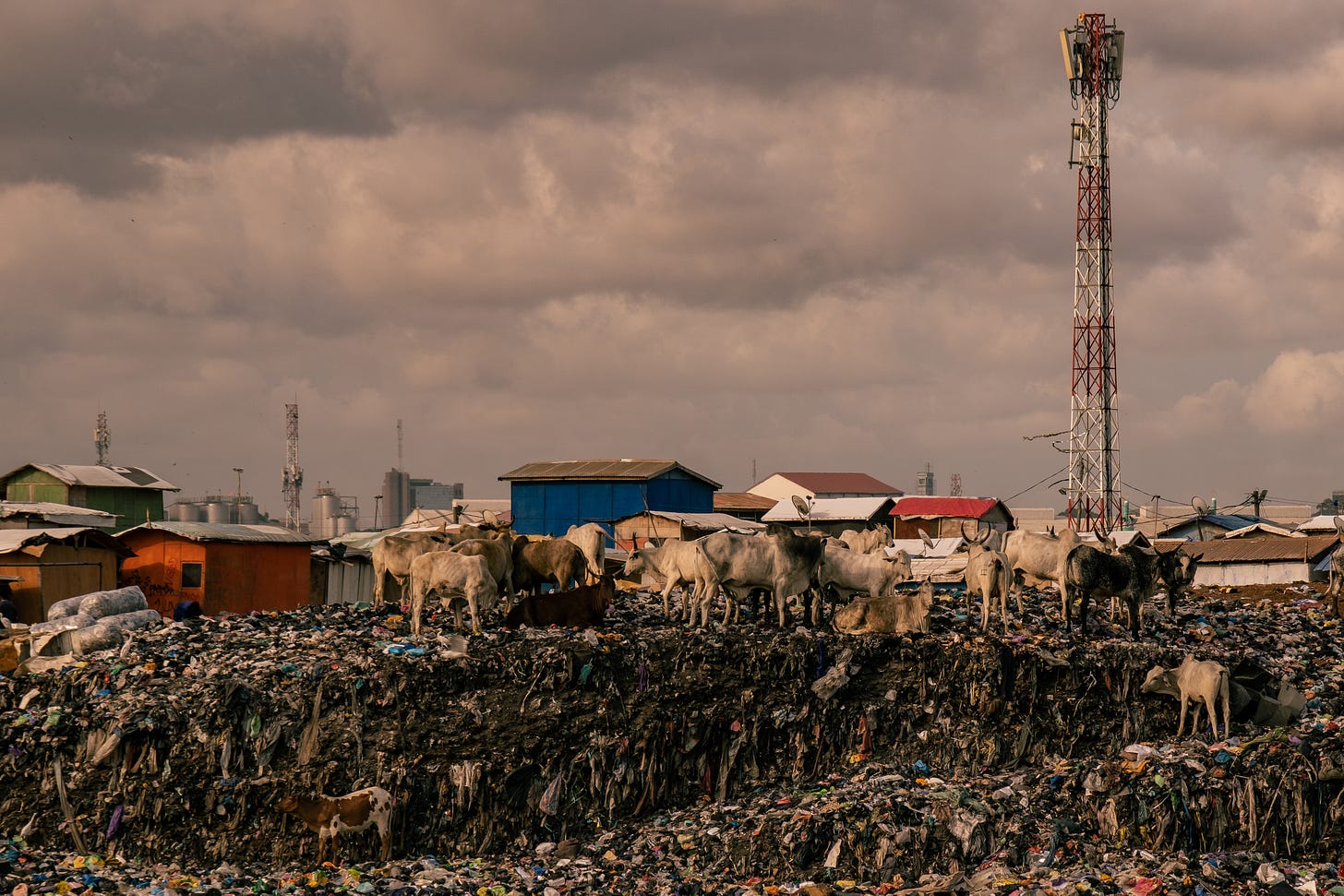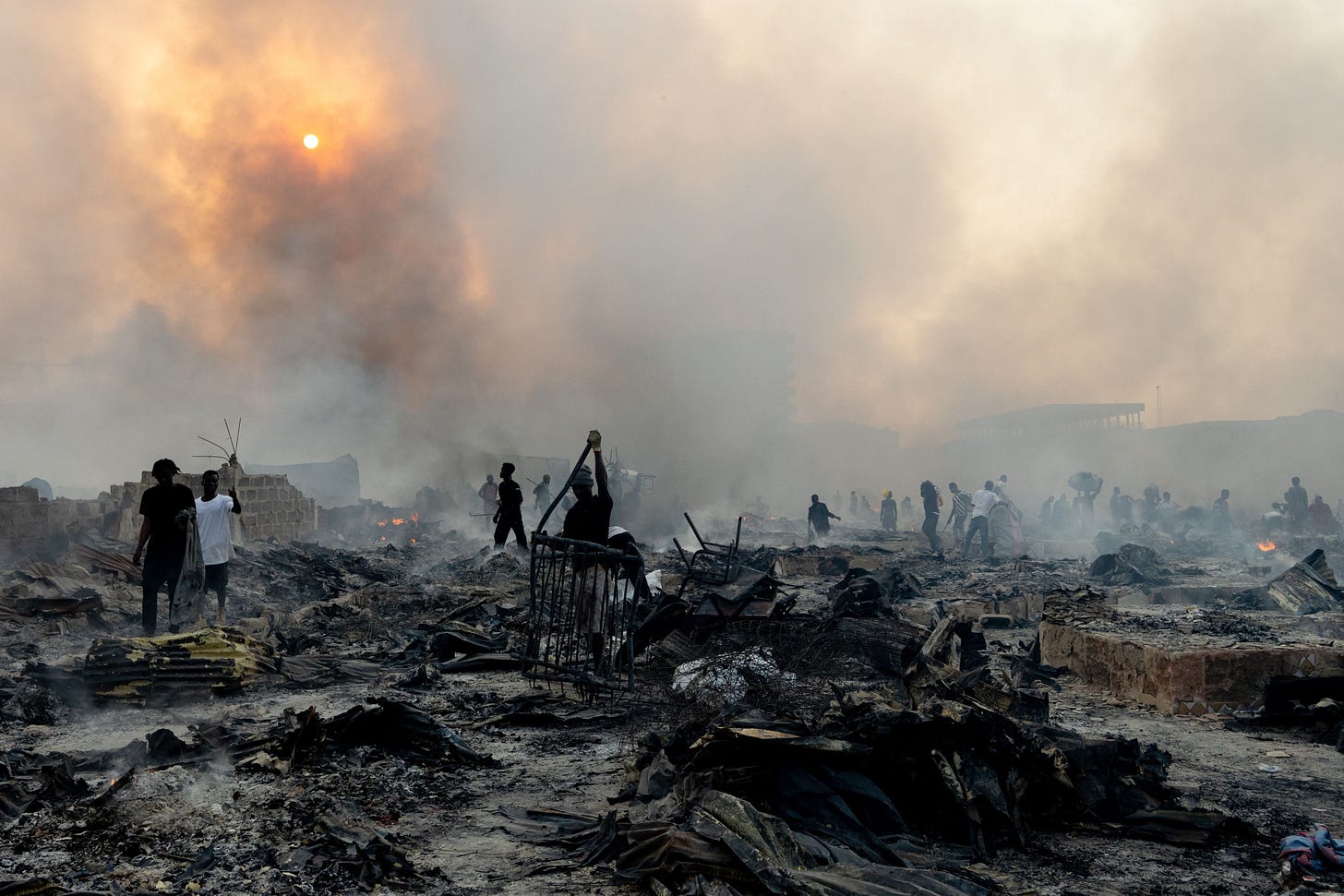My Trip and The Fire at Kantamanto
On Jan 1st The World's Largest Second Hand Market Caught Fire
At the beginning of the year - a blaze hit the World’s largest second hand market in Accra Ghana. It has devastated the area and destroyed many people’s livelihoods as a result. I’m hoping this piece raises the efforts to support the community and gives some insight into what the market and the people there.
Kantamanto market exists to serve the no longer used garments from around the world in giving them a new home, through repairers, upcyclers, designers, resellers and many others. But with the rise of fast fashion and ultra fast fashion, the market has been swamped in extremely low-quality, unsellable garments. Causing a large strain on the vendors, the surrounding area and the community.
I visited Kantamanto in June 2023 to discover the impacts our waste has on the area. The trip was part of a World Vision project to investigate child labour in the supply chains of the beauty industry, which later saw us move north to Tamale, from the capital, Accra.
The market is huge, a grid-like maze, with over 30,000 traders all stewarding their stalls and goods. The community market recirculate 25 million pieces of clothing every month, so you can find literally everything there from dresses, shoes and bags to lots of Wolverhampton Wanderers football shirts (we learned many of them had made some money gambling on Wolves and had therefore become a popular team). As you could guess there is a lot packed into a confined space; it is busy, and extremely hot.
In meeting with many vendors at the market, it was apparent that the system was broken. While people argue countries like Ghana pay to take our old clothes, these were no longer old clothes with plenty of life in them, but rather lumps of plastic which they would then be sending into their own landfill sites.
Previously they’d have items made of natural materials from decent brands known for lasting quality - Levi’s, Ralph Lauren, Charles Tyrwhitt etc., now it’s flooded with Primark, Asos, Shein and Boohoo brands. These are also evident on the shores of Accra, in rinds tied into the earth; pollution.
The issue though, is the vendors purchase the bales not knowing what’s inside, unbeknownst to them, they’re buying waste destined to pollute their own community. It is only when they unpack the bales, that they know how much is merchandise, re-sellable and of value, and how much will be passed into the pile. Some vendors told me it can be 80% of a bale that heads straight to the landfill site. Through the work of organisations on the ground, this has now become a pivotal issue to be tackled. With more resources destined for waste management, education and systems change.

The image of the landfill pile down the road in old Fadama will stick with me forever.
All I can say is, imagine a small town, only all you can see is landfill. Waste mountains that just go on and on. Large parts of it clothing that has come from the UK, U.S and other capitalist monsters in the global north. It produced one of the most overwhelming plethora of emotions I’ve ever experienced. Sadness, anger, defeat, guilt, helplessness, motivation.
But what also stuck with me from my time in Kantamanto was the spirit and energy of the people there. Surrounded by problems, their joy and sense of humour rose above. They were extremely accommodating, friendly and funny.
But as a result of last weeks fire, their livelihoods, and community are now in jeopardy. It's estimated that 60-75% of the market was destroyed, impacting approximately 10,000 people, with the investigation still ongoing. The destruction of this market is likely going to have a huge ripple effect and impact across the global second hand trade. And the world’s largest fast fashion brands aren’t going to stop producing any time soon. Thus, it appears the fashion waste crisis will continue to get worse before it gets better.
While environmental justice organisation The Or Foundation has set up a fund and committed $1M USD to immediate relief efforts, it's going to take a significant investment to revitalise the once thriving market. The organisation is working directly with market leaders and other members of the community to mobilise funds to rebuild the market, and provide direct financial assistance to impacted community members, including retailers, upcyclers and women working as kayayei (head porters), over the coming days.
Funds are immediately being dispersed to haul debris as part of the community cleanup effort. The Or Foundation is also offering immediate assistance to anyone who was injured or ill as a result of the fire.
The people of Kantamanto Market needed more support and help from us back in 2023 when I saw them, but the existence of the entire market itself, is now massively under threat and we must do everything we can to help them back to their feet. The situation has never been so desperate, and the repercussions for the planet and the industry efforts for progress, and to recirculate clothing are in real danger.
Please support if you can via the donorbox here.
https://donorbox.org/kantamanto-fire-relief-2025







